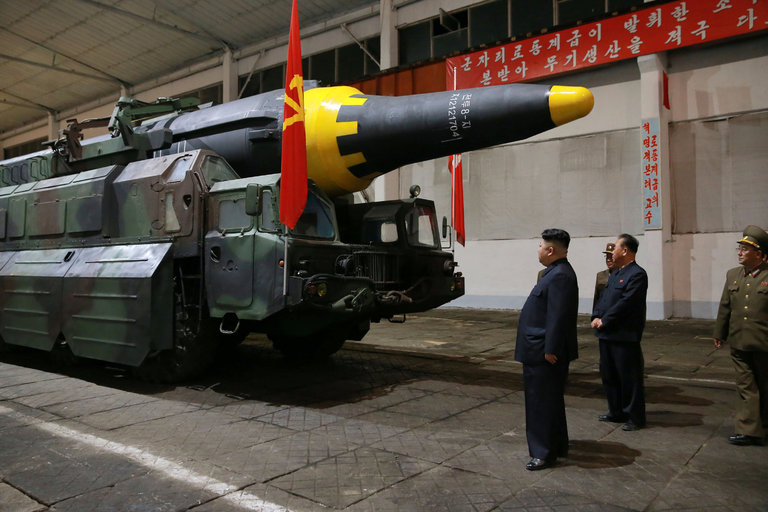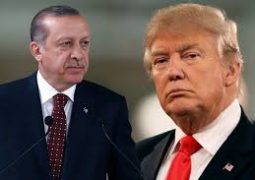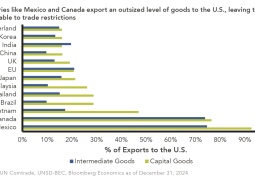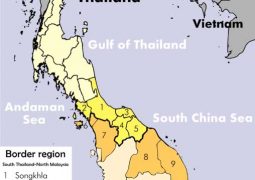North Korea Missile Test Appears to Tiptoe Over a U.S. Tripwire

For months, Washington has been bracing for North Korea to test an intercontinental ballistic missile, waiting to see how close it could get to the United States and how aggressively President Trump should react.
Now, it looks as if Kim Jong-un, the North’s 33-year-old leader, has a different plan — one intended to improve his ability to strike the United States without setting off an American military response.
Instead of going for distance, he has stepped up the testing of missiles that fly high into space — on Sunday, one reached a height of more than 1,300 miles — and then plunge down through the atmosphere, mimicking the kind of fiery re-entries a nuclear warhead would undergo if fired over a much longer distance. Instead, the payload lands in waters a few hundred miles or so from North Korea’s coast.
“They can simulate an ICBM warhead on this kind of trajectory,” David C. Wright, a senior scientist at the Union of Concerned Scientists, a private group in Cambridge, Mass., said in an interview. “It’s a kind of steppingstone.”
John Schilling, an aerospace engineer and an expert on North Korea’s missile program, called this relatively low-key experimentation a possible hedge against a military response. Sunday’s unobtrusive test, he said, could nonetheless “represent a substantial advance” that might bring the debut of a working intercontinental missile closer than previously estimated.

The best guess of nongovernmental experts puts an ICBM debut at roughly 2020. But military and intelligence officials regularly say the lack of a proven capability is different from the absence of a long-range threat to the continental United States, and they say commanders have to assume the worst given the North’s progress to date.
“We think they’ve had enough time to mate a nuclear weapon to a missile,” Michael Morell, a Central Intelligence Agency deputy director in the Obama administration, recently told “CBS This Morning.” “So the threat is now.”
Analysts said Sunday’s test flight, if conducted on a normal rather than a high trajectory, would have traveled about 3,000 miles. That is well beyond the sprawling American base at Guam, some 2,200 miles away. More important, it would make the flight distance the longest to date for one of the North’s military missiles and thus represent a major technical success for the beleaguered nation.
On Monday, the North’s official news agency said Mr. Kim hugged rocket officials after Sunday’s successful test flight. The isolated nation has recently experienced a large number of failures in its rocket fleets; last October it began an investigation into whether American sabotage was making its missiles explode, veer off course and disintegrate in midair.
The news agency said the missile that was launched Sunday flew to a very high altitude to avoid striking “neighboring countries.” The flight also stressed the mock warhead “under the worst re-entry situation,” it added.
Charles P. Vick, an expert on the North’s missiles at GlobalSecurity.org, a private research group in Alexandria, Va., said the United States had a history of using high missile trajectories as a way to intensify the returning warhead’s trial by fire.
North Korea’s Longest-Range Missile Test
If flown on a normal trajectory, the missile that North Korea tested Sunday could have flown far enough to reach Guam or apparently even as far as the Aleutian Islands off Alaska.

Altitude in miles
1,500
Missile’s trajectory
The missile flew for about 30 minutes, reaching a maximum altitude of 1,312 miles and completing a trajectory of 489 miles.
Projected trajectory – In a normal trajectory rather than a high trajectory, the same missile could have flown for 2,982 miles.
“Going really high,” he said, “gives you a very fast and very brutal re-entry.”
Still, he and Dr. Wright of the Union of Concerned Scientists cautioned that the method raised subtle questions that only a longer-range test could answer. For instance, the fiery heating, while as intense as that for an ICBM warhead, was of shorter duration.
“You learn something but not everything,” Dr. Wright said. He added that in three or four of the North’s recent successful tests, missiles have flown to unusually high altitudes.
Dr. Schilling, the aerospace engineer, posted his comments about the Sunday missile test on 38 North, a website run by the Johns Hopkins School of Advanced International Studies that specializes in North Korea analyses.
There, he suggested that the successful missile, which the North Koreans call the Hwasong-12, appeared to be a smaller version of the KN-08, a code name for Korea North Type 8. Identified by analysts as an intercontinental ballistic missile, the KN-08 made its debut in a military parade in 2012 and appears to have never undergone a successful flight test.
Dr. Schilling said the smaller version appeared in a military parade last month, adding that it had been expected to have roughly the same performance as Sunday’s test flight. “It clearly shares a common heritage” with the larger missile, he wrote.
Dr. Schilling said the new missile could represent a replacement for the Musudan, an intermediate-range missile. Last year, most flight tests of the Musudan ended in flames, giving it an overall failure rate of 88 percent. That led the North to suspect that the United States was sabotaging its missile programs.
The longer range of the new missile, Dr. Schilling wrote, might give it better odds of attacking Guam successfully but would fail to change the strategic balance. “There aren’t really any interesting targets” other than the American base, he said.
Dr. Schilling called the most interesting feature of the new vehicle its potential for “demonstrating technologies and systems to be used in future ICBMs,” including the KN-08 and a related long-range missile known as the KN-14.
Repeated flights of the new missile, he wrote, “would allow North Korea to conduct at least some of the testing necessary to develop an operational ICBM, without actually launching ICBMs, particularly if it includes the same rocket engines.”
Over all, Dr. Schilling concluded, it seems possible that North Korea with this single test flight of the new missile might already have moved “closer to an operational ICBM than had been previously estimated.” American cities will not be at risk tomorrow, or any time this year, he added, since some flight testing would still have to be done with a full-scale system.
Still, he added that the novel situation called for a reassessment of the North’s emerging skills in making an intercontinental ballistic missile.
Dr. Wright agreed that the successful test flight represented a major step forward. “If they’ve got a system with a new engine and can scale that up,” he said, “they’ve got a pretty believable path to an ICBM.”
In political signaling, he added, what the North’s test is telling the West is: “Hey, we’re on our way. If you want to talk, now’s the time to do it.”
- Previous Ageless mom: This 50-year-old Malaysian woman of Chinese origin doesn’t look a day older than 20! Here’s her secret
- Next Syria Denies Burning Bodies of Political Prisoners
















